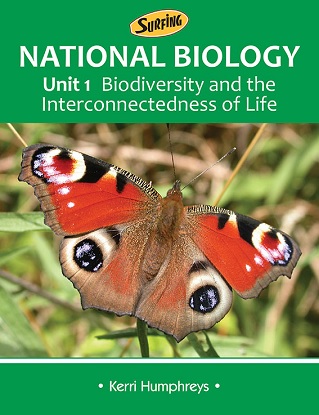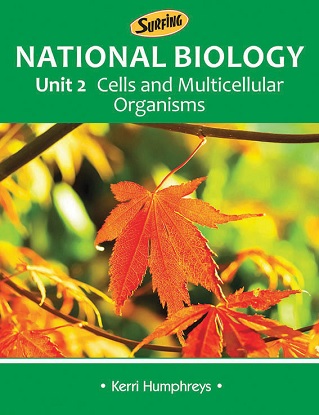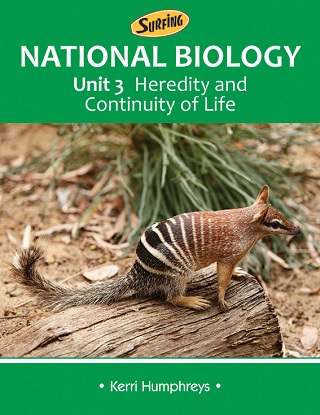National Surfing Biology Unit 1
- Kerri Humphreys
- Science Press
- 2015
- ISBN: 9780855836740
RRP: $49.95 (Inc. GST)

Description
Each book in the Surfing series contains a summary, with occasional more detailed sections, of all the mandatory sections of the syllabus, along with questions and answers.
All types of questions – multiple choice, short response, structured response and free response – are provided.
Questions are written in exam style so that you will become familiar with the concepts of the topic and answering questions in the required way.
Answers to all questions are included.
A topic test at the end of the book contains an extensive set of summary questions, including multiple choice and free response questions. These cover every aspect of the topic, and are useful for revision and exam practice. Marking guidelines are supplied where appropriate.
Table of Contents
Introduction
Words to Watch
1 Assumed Knowledge
Describing Biodiversity
2 The Biosphere
3 18th and 19th Century Naturalists
4 Classification
5 Different Classification Systems
6 Features Used in Animal Classification
7 Dichotomous Keys for Plants
8 Dichotomous Keys for Animals
9 Classification and Evolutionary Relationships
10 Classifying Extinct Organisms
11 Classification of Eucalypts
12 Renaming the Genus Acacia
13 Bird Classification
14 Biodiversity – Genetic Diversity
15 Variation in a Species
16 Variation in Koalas
17 Biodiversity – Species Diversity
18 Insect Diversity
19 Moth Diversity
20 Biodiversity – Ecosystem Diversity
21 Present Australian Biomes
22 Classifying Ecosystems on Plant Formations
23 Mangrove Ecosystems
24 Diversity of Rainforest Ecosystems
25 Diversity of Woodland Ecosystems
26 Changing Environments in Australia
27 Succession
28 Abiotic and Biotic Features of the Environment
29 Abiotic Features of Aquatic Environments
30 Australia and Abiotic Characteristics
31 Field Study – Abiotic features
32 Habitats
33 Ecological Niches
34 Supercomputers and Biology
35 International Agreements, Biology and Biodiversity
36 Biodiversity and Sustainable Development
37 Biodiversity Targets
Ecosystem Dynamics
38 The Water Cycle
39 The Carbon Cycle
40 The Nitrogen Cycle
41 The Phosphorus Cycle
42 Food Chains and Food Webs
43 Play – Inside a Food Web
44 Practice with Food Webs
45 Field Study – Food Webs in a Rock Pool
46 Decomposers
47 Uses of Energy by Organisms
48 Energy Pyramids
49 Biomass Pyramids
50 Open Ocean Food Webs and Ecological Pyramids
51 Distribution and Abundance
52 Distribution and Climate
53 Distribution Variations
54 Sampling Techniques – Transects
55 Field Study – Transects
56 Sampling Techniques – Quadrats
57 Activity – A Quadrat Study
58 Field Study – Abundance Using Random Quadrats
59 Sampling Techniques – Percentage Cover
60 Field Study – Percentage Cover
61 Sampling Animal Populations
62 Experiment – Capture-Mark-Recapture
63 Population Ecology
64 Trends in Population Estimates
65 Predator-Prey Populations
66 Competition for Resources
67 Mutualism
68 Parasitism
69 Commensalism
70 Allelopathy
71 Disease
72 Adaptations
73 The Platypus
74 Acacia in Australia
75 The Changing Distribution of Australian Species
76 Responses to Changed Conditions
77 Bettongs in Australia
78 Tasmanian Devils in Australia
79 Field Study – Organisms on a Rock Platform
80 Ecosystem Modelling
81 Human Activities – Introduced Species
82 The Introduced Cane Toad
83 Human Activities – Removal of Biomass
84 Human Activities – Use of Fertilisers
85 Eutrophication
86 Human Activities – Changing Water Availability
87 Human Activities – Use of Pesticides
88 Biomagnification
89 Pollution
90 Strategies to Balance Human Activities
91 Field Study – Human Impact
92 Indigenous Knowledge of Ecosystems
93 Marine Reserves
94 Keystone Species and Conservation
95 Writing a Practical Report
Topic Test
Answers
Index





